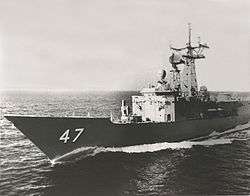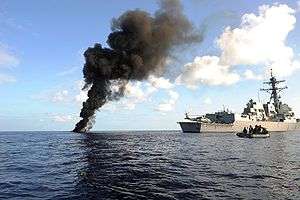Action of 1 April 2010
The Action of 1 April 2010 refers to a pair of naval engagements fought between United States Navy warships, a Sierra Leone merchant ship, and Somali pirate vessels operating off the Seychelles in the Indian Ocean.

| Action of 1 April 2010 | |||||||
|---|---|---|---|---|---|---|---|
| Part of Piracy in Somalia, Operation Ocean Shield, Operation Enduring Freedom - Horn of Africa | |||||||
 USS Farragut after destroying a pirate skiff in the Indian Ocean, an American boarding party is also depicted. | |||||||
| |||||||
| Belligerents | |||||||
|
| Somali Pirates | ||||||
| Commanders and leaders | |||||||
|
| unknown | ||||||
| Strength | |||||||
|
United States: 1 destroyer 1 frigate 1 helicopter Merchant fleet: 1 tanker |
1 trawler 4 skiffs | ||||||
| Casualties and losses | |||||||
|
1 frigate damaged 1 tanker damaged |
1 trawler captured 2 skiffs sunk 16 captured | ||||||
Action
The frigate USS Nicholas was attacked by small arms from a pirate skiff while steaming off the coast of Kenya and the islands of Seychelles. Nicholas returned fire with a 50-caliber deck gun and disabled the vessel and three pirates surrendered. Commander Mark Kesselring ordered the skiff sunk and proceeded to attack the nearby pirate mother ship from which the skiff was operating. After a chase the mothership was captured and two more pirates were taken into United States Navy custody. The pirate mothership was likely a small steam powered vessel fitted out as a naval trawler which are regularly used by Somali pirates. The ship was confiscated by the Americans according to news reports and pirates were put in Nicholas' brig, to await court either in Kenya or the United States.
That same day, the destroyer USS Farragut, as flagship of Combined Task Force 151, was involved in a pirate attack on a Sierra Leone-flagged tanker, MV Evita. The incident also occurred in waters north-west of the Seychelles. Evita was fired on by three skiffs but was able to escape and increase speed and due to her crew who shot flares at the rifle and rocket-propelled grenade-armed pirates. The attack was reported to the nearby USS Farragut which arrived in the battle area and began operations. The vessels were boarded by American personnel and a SH-60B Seahawk covered the mission from the air. The pirate mother skiff was sunk later on by gunfire or explosives and after the pirates were stripped of their means to commit piracy, they were loaded onto the other two skiffs and freed. Eleven pirates were captured in total. Several fuel drums and grappling hooks were found aboard the boats. The pirate weapons, ammunition and other equipment such as ladders were seen thrown overboard by the Americans before the pirates were captured. Nobody is believed to have been injured during the engagements.
Aftermath
The captured pirates from the first incident were detained by the United States Navy until it was determined that they would be transferred to the United States to stand trial for piracy. After capture, the pirates were identified as Mohammed Modin Hasan, Gabul Abdullahi Ali, Abdi Wali Dire, Abdi Mohammed Gurewardher, and Abdi Mohammed Umar. The five pirates, were put in the custody of the United States Marshal Service and charged with a variety of piracy and weapons related charges. The pirates were charged and tried in the United States District Court for the Eastern District of Virginia in Norfolk, Virginia where they were convicted and sentenced to serve in prison for life.[1][2]
